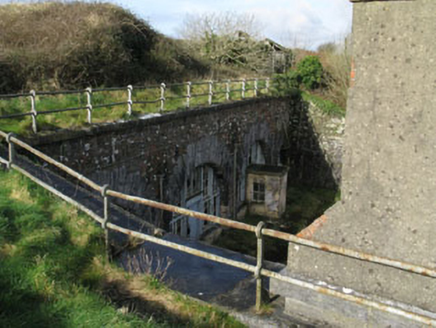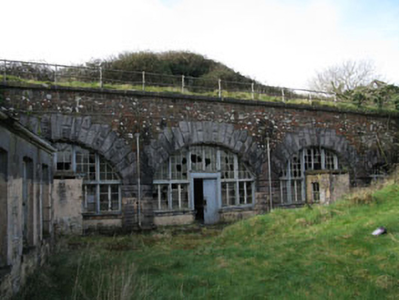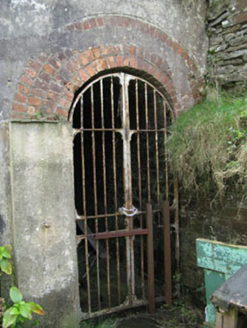Survey Data
Reg No
20909941
Rating
Regional
Categories of Special Interest
Architectural, Historical, Social, Technical
Previous Name
Camden Fort
Original Use
Barracks
Historical Use
Prison/jail
Date
1790 - 1810
Coordinates
180802, 61786
Date Recorded
12/03/2009
Date Updated
--/--/--
Description
Underground U-plan four-bay single-storey soldiers' quarters and store, built c.1800, later in use as prison. Lean-to extension to side (east), and porches to east and west bays of front (north). Now disused. Earth covered roof with metal railings and limestone block eaves course. Cast-iron rainwater goods. Dressed sandstone walls. Segmental-headed arcaded openings with margined rusticated limestone piers, voussoirs, and keystones. Timber framed multiple-pane windows with red brick stall risers and limestone sills. Square-headed door opening to centre with replacement timber battened door. Red brick porches having flat roof with cornice and corbels. Square-headed window openings with concrete sills, having two-over-two pane timber sliding sash windows. Square-headed door openings to porches having battened timber doors. Single pitched slate roof to lean-to extension, having red brick chimneystack and limestone copings. Snecked sandstone walls. Camber-headed window openings with tooled limestone surrounds, sills, voussoirs and keystones having six-over-six pane timber sliding sash windows. Camber-headed door opening with square-headed timber panelled door with overlight and blind sidelights. Granite steps to side (east) and underground entrance way to north of steps with round-headed door opening having cast-iron gate. Various related structures to site.
Appraisal
One of the original buildings within Fort Meagher (formerly Camden Fort), its construction is similar to the main barracks located on the opposite side of the grounds. A high level of workmanship and quality materials went into its construction. The large rusticated arches forming the bays are especially interesting. Used as a convict prison from 1850-65, Camden Fort subsequently returned to military use, and together with its twin, Carlisle Fort, on the opposite side of the harbour, was redeveloped using convict labour from the adjacent Spike Island. Together with other military buildings in the harbour area, it remained in British use until 1938, at which time the Treaty Ports were transferred to the Irish State.













